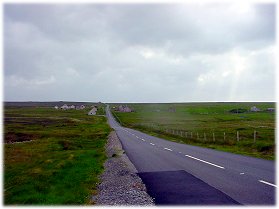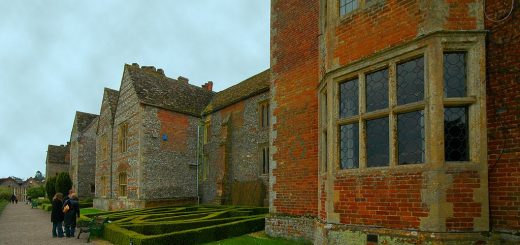Bishop’s Palace, Darlington
Built in 1970, the Town Hall now stands on the site of the old Bishop’s Palace in Darlington and there is a story associated with this older building concerning the English Civil War, the murder of a local Lady and her subsequent ghost.
The following account of the haunting appeared in the Shields Gazette on Wednesday 20 May 2009 in an article by Mike Hallowell entitled ‘Has the Grey Lady found a new haunt?’
THE Old Bishop’s Palace in Darlington was a beautiful building. Alas, it was demolished by the local council in 1938, and with it went a slice of sinister history.
Many moons ago, when our nation was suffering from the turbulence of the Civil War, a certain Lady Jarrett was left alone at the palace for reasons which are obscure.
What happened subsequently has been the subject of much debate, but one story is that she was murdered by her footman.
However, the general consensus is that she was spotted walking in the grounds by a roaming band of Cromwellian Roundheads, whose moral standards were even lower than the self-righteous, but utterly despicable, Cromwell himself.
According to legend, the men chased (or dragged) Lady Jarrett into the palace and robbed her.
They were especially interested in a valuable ring on her finger, but were unable to remove it.
So they did the obvious; they simply removed her entire hand at the wrist with one slash of a sword.
The men gathered up whatever else they could find of value and
fled. Lady Jarrett left the lounge awash with blood, including a bloodied handprint on one of the stone flags.
She staggered outside and managed to reach an archway before collapsing.
It wasn’t long before Lady Jarrett’s ghost was seen in the palace, colloquially known as the Grey Lady.
Historian RA Luck testified that attempts to remove her bloody handprint and the bloodstains were unsuccessful.
Luck himself heard the dead woman’s eerie footfalls on numerous occasions, he also detected the sound of rustling silk dress and even felt her breath on his face.
On one occasion, Luck visited the haunted room with his family.
At 2am he crept out of bed and returned, counted to 200 and waited – but Jarrett’s ghost did not reappear.
Despite possessing a good reputation during her life, after death Lady Jarrett’s ghost became malevolent.
In 1854, she was described by the historian W Hylton Dyer Longstaffe as “a Robin Goodfellow”.
Robin Goodfellow is a mischievous sprite who is renowned in folklore for playing tricks on unwary passers-by. Other witnesses speak more kindly of her.
On a number of occasions, her spirit was said to have turned up at a local workhouse and made coffee for the residents.
Lady Jarrett’s ghost was seen wandering among crowds of shoppers in the town centre, her last recorded appearance being, to my knowledge, in 1938.
The arch in which the dying Lady Jarrett was found has since been moved to the Grotto Garden, at South Park, where it can still be seen to this day.
The site of the palace, commonly known as the Leadyard, now plays host to the town hall.
It is rumoured that an underground tunnel exists at the site which leads to St Cuthbert’s Church.
Here, allegedly, the spectre of Lady Jarrett has taken up residence since the demolition of the palace.
Other witnesses claim to have seen the ghost of the Grey Lady staggering through the tunnel which now stands in the Grotto Garden.
Several have also reported seeing her apparition glide across the River Skerne, her face bearing an incredibly sad countenance as if lamenting her fate.
What really happened to Lady Jarrett that fateful night will probably never be known; however, there have been many witnesses over the centuries who have testified sincerely that her violent death did not remove her spirit from the old Bishop’s Palace.




Re: Bishop’s Palace, Darlington
‘The History and Antiquities of the Parish of Darlington’ (1854) by William Hylton Dyer Longstaffe.
The Gerrards or Jarratts would be left in a very incomplete state were I not to glance at the unearthly tread of Lady Jarratt who still inhabits the old Manor House. It would be unpardonable to omit the veracious oral chronicles of her being murdered by some soldiery and her leaving on a wall a ghastly impression of thumb and fingers in blood for ever and far be it from me to attempt to philosophize on the fact that no scouring or whitewashing could ever eradicate it. Yes there were crimson spots on both wall and floor And though workhouse arrangements have caused their destruction poor Lady Jarratt’s fate is still remembered. She has but one arm for the other was cut and carried off by the ruthless warriors that they might obtain a valuable ring thereon. Like the Silkies and cauld lads of the north her ideas are composed of mischief and benevolence in equal proportions. Her grand sanctum is a supposed subterranean passage leading from the mansion to the church which has been credat Judceus ApeUa sometimes discovered but never dared to be explored yet she is fond of perambulating in the midnight chill and the golden sunrise. She sits on the boundary wall and terrifies children on their road to toil on the opposite side of the stream at the factory which she mortally hates making a house near it perfectly untenantable. Her musical tastes are not very refined she jingles the pans of the establishment and rattles the old pump handle when it is locked with great assiduity. These pranks accompany a very undesirable liking for maidens bedsides when the bedclothes from the bed pulls she and lays them naked all to view twixt sleepe and wake she does them take and on the key cold floor them throw and generally are perpetrated before births and deaths in the workhouse community. On these occasions she relents and makes coffee for the sick and in all her various appearances and offices within doors invariably makes a rustle me tustle with her stiff silk dress but in the town she sinks into the very numerous community of white rabbits scampering about the market place in most gallant style In fact she is Robin Goodfellow under another name.
Re: Bishop’s Palace, Darlington
The following description of the Bishop’s Palace was published in ‘The history and antiquities of the parish of Darlington’ (1854) by William Hylton Dyer Longstaffe. ‘The bishop’s manor house at Darlington, is situate due south of the church. Passing through the court-yard, we come to a doorway on the north of the building, which has been pointed; indeed, the bounding label still remains. In a direct line with this is a neat little early English arch, the remnant of Pudsey’s work, shut up in a sort of pantry. It was formerly the entrance of a long arched passage, leading to what is now a hen-house, supposed to have been a dungeon; though why, it would be somewhat difficult to find out. This passage is now completely removed, and the hen-house so modernized as to retain little that appertaineth to "hoare antiquitie" save the massive stone walls. To this I ought to add that the floor has been raised, and the arch somewhat curtailed of its fair proportions. To the right of the space between the outer doorway and the arch is a large room of later architecture, apparently a hall. It is lighted by small, square, oblong lights; and at the west end are two doorways, flat four-centered; one leading into a closet, the other into the modem part of the workhouse. The wall-plate of the roof –also late florid– remains above these arches, showing the moulding of the ribs, which appear to have divided the roof into a series of square panels. The exterior roofs of the whole ancient part of the building are of good pitch, and are plain oak, as the work- house-master informed me; but the exact plan of the mansion cannot now be ascertained. One high square chimney retains an early corbel table, formed of minute arches. To the left of the entrance, and opposite the hall before described, is "the chapel" (St James’s). The whole of the exterior is roughcast. One may still see three Norman lights in the eastern gable (pointing out the date, 1160, as a probable one), and the sides had also small circular-headed lights of extremely deep splay. The chapel formerly opened out of the entrance passage by an enriched doorway, but the whole is now modernized. The foundation will be noticed in the Ecclesiastical Division. Up stairs, are the remains of what is termed " the anquetting room," which has had traceried windows, one now fbnning a doorway. There is also a plain early stone fireplace. In ancient times, we find the plot of ground on which the mansion stands called Hallgarth. The Manor House was bought by the township in 1806, for the purposes of a poor-house. It had been so used for some time before. A large pile of new buildings was erected to the south in 1808, the cost being partly deferred by the bequest of Mr. G. G. Phillips.’